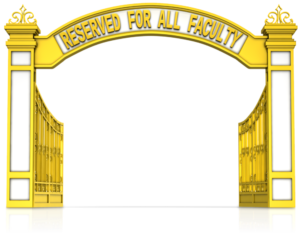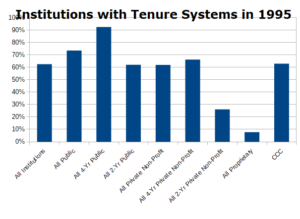
In a previous post A New Millennium – The Same Old Story, Part I, I introduced the topic of Faculty Reward Systems and Faculty Priorities as one of the current crises in the academy. In the short note about these problems, I referenced an article written in 2001 with the intriguing title Paradise Lost: How the academy converts enthusiastic recruits into early-career doubters. In the almost two decades since that article appeared there have been hundreds of articles lamenting the doleful and declining conditions in the academy for all faculty, not just the early recruits, but even the seasoned veterans.

My first reaction to the article’s title was one of affirmation. I thought I understand the authors’ frustration with the impression that faculty as a whole had lost access to the Garden of Eden, the Land of Milk and Honey. However, the more I reread Milton’s tragic epic the more confused I became. The allegoric allusions between the Biblical creation story and the plight of modern university faculty made less sense to me.

In his 1674 version, Milton begins Paradise Lost – Book I with a verse that is often referenced and quoted:
OF Mans First Disobedience, and the Fruit
Of that Forbidden Tree, whose mortal tast
Brought Death into the World, and all our woe,
With loss of Eden, till one greater Man
Restore us, and regain the blissful Seat,
Sing Heav’nly Muse, that on the secret top
Of Oreb, or of Sinai, didst inspire
That Shepherd, who first taught the chosen Seed,
In the Beginning how the Heav’ns and Earth
Rose out of Chaos: or if Sion Hill
Delight thee more, and Siloa’s brook that flow’d
Fast by the Oracle of God; I thence
Invoke thy aid to my adventrous Song,
That with no middle flight intends to soar
Above th’ Aonian Mount, while it pursues
Things unattempted yet in Prose or Rhime.
And chiefly Thou, O Spirit, that dost prefer
Before all Temples th’ upright heart and pure,
Instruct me, for Thou know’st; Thou from the first
Wast present, and with mighty wings outspread
Dove-like satst brooding on the vast Abyss
And mad’st it pregnant: What in me is dark
Illumin, what is low raise and support;
That to the highth of this great Argument
I may assert Eternal Providence,
And justifie the wayes of God to men.

Having read the Trower, Austin, and Sorcinelli article many times, I don’t get any sense that they are attempting to “justify the ways of God to men.” On the contrary, they are blaming fate and the evil administrations of universities for taking away the riches of which they had dreamed and for which they had worked so hard. I find no sense of contrition or admission of wrongdoing on the part of the faculty that have been expelled from paradise.

I selected this article to introduce the topic for a number of reasons. The first reason was very personal. The article was based on the authors’ presentation at the 2001 Conference on Faculty Roles & Rewards, held February 1–4, 2001, in Tampa, Florida. The three authors of the article, Cathy A. Trower, Ann E. Austin, and Mary Deane Sorcinelli, were invited by Gene Rice, director of the American Association of Higher Education Forum on Faculty Roles & Rewards to make a combined panel presentation at the Forum’s annual meeting.

I was at that Forum and I remember their presentation and the mixed response it received from the audience. The faculty side of the crowd loved and cheered the presentation and its conclusions. The administrators in the audience viewed the presentation with semi-veiled skepticism. A couple of trustees with whom I spoke after the presentation expressed undisguised disdain for any thought that faculty had an unalienable right to Nirvana and that trustees were in any way or form complicit in destroying paradise.

I think I missed only one of the dozen Forums on Faculty Roles & Rewards sponsored by the AAHE before it folded in 2005 due to lack of support from the higher education community. In my mind that was a sad day for American higher education.
The American Association of Higher Education was the only membership organization in higher education that was fully open to everyone involved in higher education. It embraced graduate students, faculty, student affairs professionals, administrators, trustees, the staff of higher education organizations, government officials, journalists, higher education commentators, and funding sources.

In the end, its diversity was probably the prime reason for its downfall. It wasn’t specialized enough. Many faculty thought student affairs professionals and administrators had nothing to offer them. Student affairs professionals and academic administrators used different languages. Trustees became quickly frustrated with the bickering between the groups. Graduate students were only interested in finishing their degrees and getting jobs. The government officials felt belittled and badgered for more money for education. Commentators and journalists found cheaper ways to get the stories they needed for their articles. The funding sources only heard cries for more funds and saw little appreciation for their prior gifts.
In spite of its obvious problems, I still believe the AAHE was the best higher education association of the 20th Century. It was a one-stop shop for the most recent research on higher education topics and practical solutions to higher education’s most troublesome problems which had been tested in the crucible of real applications.

In the interest of full disclosure, I admit that I had a soft spot in my heart for the AAHE which impacted my choice of the introductory article. I was privileged to make presentations at ten AAHE conferences: one Annual Meeting; two Technology Conferences; two Faculty Roles & Rewards Forums; and five Assessment Forums. I was invited to make one presentation at a Faculty Roles & Reward Forum and one at an Assessment Forum. For that Assessment Forum, my presentation was designated the principal offering of a given time slot and I had my picture in the conference program. I felt honored to have the opportunity to present an assessment research project design to an audience of over 2,000 higher education professionals at one time. The other eight AAHE presentations went through the normal vetting process by which conference presentation proposals were judged.

The invitation to present at the Faculty Roles & Rewards Forum came from Gene Rice. Six months after the AAHE conference where Trower, Austin, and Sorcinelli presented their research findings, Gene Rice was the keynote speaker at a Faculty Development Conference sponsored by the Council For Christian Colleges (CCC). This organization was the predecessor to the Coalition for Christian College & Universities (CCCU). In that intimate setting of approximately 80 faculty members and administrators from 50 Christian colleges, Gene made three plenary presentations over the three-day conference. The format for the conference called for a structured panel response and an audience free Q&A sessions after each of Gene’s talks. I was scheduled to be on one of those panels. However, when at the last minute a panel member for another talk had to withdraw, I was asked to sub on that panel also. Thus, I had the opportunity to comment on Gene’s work twice during the conference, in addition to a presentation that I made on some research that I did on faculty salary models and scales within the CCC.
This conference was not the first time that I had met Gene Rice. Due to his close association and work with Ernie Boyer, Gene spoke once at Messiah College. Ernie was an alumnus and a long-time trustee of Messiah College. However, whatever I said at the CCC Faculty Development Conference must have impressed him. He sought me out at the luncheon on the closing day of the conference and invited me to present at the next Faculty Roles & Rewards Forum. I told him I would think about it, and 30 seconds later I agreed to do it.
As early as 1970, discussions were beginning about where faculty allegiance and hearts were. Were faculty more likely to be loyal to their institution or more committed to their discipline? The answer wasn’t even close. The overwhelming majority of faculty felt more loyalty to their discipline than to their institution.
There are several reasons for this. The first is the discipline was their first passion. They have spent years immersed in the discipline, training and straining to reach its heights. They see the institution as a means to the end. It is a necessary evil to achieve their goal of climbing to the summit of the discipline.

The second is expressed by James Dixon (pseudonym of a professor in the humanities at a college in the South) in the Chronicle of Higher Education December 2015 article Loyalty, Schmoyalty: What do you do when your devotion to your institution is not reciprocrated?. Dixon in a vindictive diatribe decries the “corporatist administrators”, “bitter colleagues”, and the “faceless abstractions like departments and colleges” that inhabit higher educational institutions. [Italics mine]

Dixon summarizes the main points of the article, in the middle of it with the following paragraph:
“But at this point in my career, my priorities have changed. I simply decline to do anything for my department or institution that: (a) interferes with my family life, (b) isn’t strictly required by my contract, or (c) does nothing to benefit me or the people I care about most.”

Dixon goes on to state that senior, tenured faculty should concentrate on the things that can reward them with love and respect: their family, their discipline, congenial colleagues, and the process of teaching. Leave all the grunt work like committees [Italic emphasis, mine] to the junior, non-tenured faculty so that they can reach the point in their careers where they can concentrate on the really important things. [Italic emphasis, mine]

As a means to an end, institutions do provide faculty with monetary rewards in order to “make a living for oneself and one’s family.” Over the past half-century, there has been much discussion about this. Returning to Gene Rice and why he asked me to present at the Faculty Roles and Rewards Forum, my presentation at the CCC conference was on some research that I had done on faculty pay.
At this time, as a group, the 80+ CCC institutions were fairly uniform. They were generally small. The average enrollment was about 1,200 students. They averaged just under 100 full-time faculty members. Although a few of them were experimenting with non-traditional education and graduate education, most were almost exclusively traditional, residential, liberal arts and sciences, undergraduate colleges.

In one way that the CCC institutions resembled the rest of higher education was the fact that more than 97% had a traditional ranking system for faculty: Instructor, Assistant Professor, Associate Professor, and Full Professor. Only two institutions in the organization did not have faculty ranks.

There were small differences between the CCC institutions and higher education in general related to the question of faculty tenure. In 1995, according to AAUP statistics, approximately 35% of all faculty were tenured or on tenure-track, while 33% were part-time faculty and almost 20% were graduate students. However, the AAUP statistics also indicated that 65% of all full-time faculty were tenured or on tenure-track. College Board data indicates that 92% of public four-year institutions had tenure systems, while 66% of private four-year institutions offered tenured.
The 1995 picture at CCC institutions was slightly different. The percentage of all faculty that were part-time was just over 40%. Since very few of the CCC institutions offered graduate programs, less than 1% of faculty were graduate students. Just over 37% of CCC institutions did not offer tenure at all, mirroring the College Board data for private four-year institutions. At the CCC institutions, just over 50% of all full-time faculty were tenured or on tenure-track, which is less than the percentage for all institutions from the AAUP data.

One key aspect of my research was the question of whether institutions used a faculty pay scale or relied on annual negotiations or a negotiated starting salary and fixed annual increases. Similar data is not readily available for all four-year institutions. For the CCC institutions in my data set, 97% had fixed salary scales of some sort. Only 2% relied on a negotiated starting salary with fixed annual increases, with the other 1% resorting to annual negotiations.
In my survey, I found that 80% of CCC institutions claimed they had no disciplinary differentials in their salary scales. This egalitarian approach seems to be much different from the general higher education approach. Most likely it is an expression of the faith-based, Biblical ideal of equality and reverence for everyone, and the common service for the Kingdom.
“There is neither Jew nor Greek, there is neither bond nor free, there is neither male nor female: for ye are all one in Christ Jesus.” (Galatians 3:28, KJV)
The results of the annual College and University Professional Association for Human Resources (CUPA-HR) salary survey show significant differences by discipline in salaries for faculty with the same rank and experience across all of higher education. Salaries for business and finance faculty average twice the salaries for humanities and social science faculty. Overall, the salaries at CCC institutions ranged from 30 to 70% of the salaries listed in the AAUP or CUPA-HR surveys. CCC faculty saw their teaching as a ministry to which they were called.
For all of the institutions that indicated that they had a fixed salary scale, they described it in terms of ladders or sets of stairs. They all began with one uniform base salary. The differences occurred in what institutions used to determine an initial salary and annual increments.
In my survey, I asked about items that went into determining a faculty member’s initial salary. Every institution indicated that a faculty member’s academic experience, academic degrees and credentials, and starting rank were included as factors in starting salaries. Only 25% of institutions included a factor for professional experience outside the academy. As noted earlier, 20% of CCC institutions factored an individual’s discipline into the salary equation. In all such cases, this factor was positive for a few in-demand disciplines, while there were no subtractions for the many disciplines with lesser demand.

I next asked about annual increases. In the decade from 1985 to 1995, the national economy was generally good and inflation had cooled off after the flame up of the 1970s. There was only one downturn around 1992. Therefore, I asked during the decade 1985 to 1994, how many times were salary increases given. Within my survey universe of CCC institutions, 50% gave increases every year, 25% withheld salary increases once, 15% withheld salary increases twice, and 10% withheld increases 2 or more times.
The next set of questions dealt with the factors that went into determining the amount of the increases when they were given. Every institution indicated that they gave an increase for the extra year of service and any promotion in rank that occurred during the preceding year. In addition, 60% of the institutions said that they gave credit for being awarded tenure.
One of the hot buttons in faculty salary and reward circles of this period was the question of merit pay. Of the CCC institutions, 50% said that they rewarded meritorious service with a monetary award. Most of these (42% of all CCC institutions) offered these rewards as one-time bonuses, while the remainder (8% of all CCC institutions) gave the faculty member a step reward, which in effect carried over to succeeding years.
The final set of questions in my survey dealt with whether institutions took inflation into account in salary increases and, if so, how did they handle it. Of the 90% of CCC institutions that regularly gave annual increases (7 or more times in the decade 1985 to 1995), a significant majority (70%) treated the Cost of Living Adjustment (COLA) as an adjustment to the previous year’s salary, which meant it carried over from year to year. The remaining institutions (30%) credited the COLA as an adjustment to the base salary only. Over the years, this had a negative effect on faculty salaries in keeping up with the cost of living.
The final question returned to the question of the compressed nature of CCC faculty scales in light of the tendency toward egalitarianism. As a Chief Academic Officer, I can guarantee that it was much easier for me to hire an entry-level faculty member rather than a senior faculty member. This was particularly true if the senior faculty member was coming from a public or non-sectarian four-year institution. Our entry level salaries compared much more favorably to other institutions than did our senior-level salaries. The last question asked whether annual increases were applied equally across the board, or were adjustments made by rank. Not surprisingly, egalitarianism won out. More than 80% said increases were always equal percentage-wise across the board. Only 20% said that occasionally adjustments were made by rank, in order to honor senior faculty.

After presenting this data, my colleagues from public and non-sectarian institutions expressed surprise and pity. They could not understand how CCC institutions could attract quality faculty under these conditions. My answer was that we couldn’t attract them. They had to have a sense of calling from God, and that His Spirit did the convincing.
The next crisis facing American higher education with which I will attempt to deal is The Commercialization of Higher Education.












